Christoph Salge
Game Innovation Lab, Department of Computer Science and Engineering, New York University, New York City, NY, USA, Sepia Lab, Adaptive Systems Research Group, Department of Computer Science, University of Hertfordshire, Hatfield, UK
Exploring Minecraft Settlement Generators with Generative Shift Analysis
Sep 11, 2023Abstract:With growing interest in Procedural Content Generation (PCG) it becomes increasingly important to develop methods and tools for evaluating and comparing alternative systems. There is a particular lack regarding the evaluation of generative pipelines, where a set of generative systems work in series to make iterative changes to an artifact. We introduce a novel method called Generative Shift for evaluating the impact of individual stages in a PCG pipeline by quantifying the impact that a generative process has when it is applied to a pre-existing artifact. We explore this technique by applying it to a very rich dataset of Minecraft game maps produced by a set of alternative settlement generators developed as part of the Generative Design in Minecraft Competition (GDMC), all of which are designed to produce appropriate settlements for a pre-existing map. While this is an early exploration of this technique we find it to be a promising lens to apply to PCG evaluation, and we are optimistic about the potential of Generative Shift to be a domain-agnostic method for evaluating generative pipelines.
Automated Isovist Computation for Minecraft
Apr 07, 2022



Abstract:Procedural content generation for games is a growing trend in both research and industry, even though there is no consensus of how good content looks, nor how to automatically evaluate it. A number of metrics have been developed in the past, usually focused on the artifact as a whole, and mostly lacking grounding in human experience. In this study we develop a new set of automated metrics, motivated by ideas from architecture, namely isovists and space syntax, which have a track record of capturing human experience of space. These metrics can be computed for a specific game state, from the player's perspective, and take into account their embodiment in the game world. We show how to apply those metrics to the 3d blockworld of Minecraft. We use a dataset of generated settlements from the GDMC Settlement Generation Challenge in Minecraft and establish several rank-based correlations between the isovist properties and the rating human judges gave those settelements. We also produce a range of heat maps that demonstrate the location based applicability of the approach, which allows for development of those metrics as measures for a game experience at a specific time and space.
Reliably Re-Acting to Partner's Actions with the Social Intrinsic Motivation of Transfer Empowerment
Mar 07, 2022



Abstract:We consider multi-agent reinforcement learning (MARL) for cooperative communication and coordination tasks. MARL agents can be brittle because they can overfit their training partners' policies. This overfitting can produce agents that adopt policies that act under the expectation that other agents will act in a certain way rather than react to their actions. Our objective is to bias the learning process towards finding reactive strategies towards other agents' behaviors. Our method, transfer empowerment, measures the potential influence between agents' actions. Results from three simulated cooperation scenarios support our hypothesis that transfer empowerment improves MARL performance. We discuss how transfer empowerment could be a useful principle to guide multi-agent coordination by ensuring reactiveness to one's partner.
Comparing PCG metrics with Human Evaluation in Minecraft Settlement Generation
Jul 06, 2021



Abstract:There are a range of metrics that can be applied to the artifacts produced by procedural content generation, and several of them come with qualitative claims. In this paper, we adapt a range of existing PCG metrics to generated Minecraft settlements, develop a few new metrics inspired by PCG literature, and compare the resulting measurements to existing human evaluations. The aim is to analyze how those metrics capture human evaluation scores in different categories, how the metrics generalize to another game domain, and how metrics deal with more complex artifacts. We provide an exploratory look at a variety of metrics and provide an information gain and several correlation analyses. We found some relationships between human scores and metrics counting specific elements, measuring the diversity of blocks and measuring the presence of crafting materials for the present complex blocks.
The AI Settlement Generation Challenge in Minecraft: First Year Report
Mar 27, 2021



Abstract:This article outlines what we learned from the first year of the AI Settlement Generation Competition in Minecraft, a competition about producing AI programs that can generate interesting settlements in Minecraft for an unseen map. This challenge seeks to focus research into adaptive and holistic procedural content generation. Generating Minecraft towns and villages given existing maps is a suitable task for this, as it requires the generated content to be adaptive, functional, evocative and aesthetic at the same time. Here, we present the results from the first iteration of the competition. We discuss the evaluation methodology, present the different technical approaches by the competitors, and outline the open problems.
* 14 pages, 9 figures, published in KI-K\"unstliche Intelligenz
Applications of Artificial Intelligence in Live Action Role-Playing Games
Aug 25, 2020
Abstract:Live Action Role-Playing (LARP) games and similar experiences are becoming a popular game genre. Here, we discuss how artificial intelligence techniques, particularly those commonly used in AI for Games, could be applied to LARP. We discuss the specific properties of LARP that make it a surprisingly suitable application field, and provide a brief overview of some existing approaches. We then outline several directions where utilizing AI seems beneficial, by both making LARPs easier to organize, and by enhancing the player experience with elements not possible without AI.
Warmth and Competence to Predict Human Preference of Robot Behavior in Physical Human-Robot Interaction
Aug 13, 2020



Abstract:A solid methodology to understand human perception and preferences in human-robot interaction (HRI) is crucial in designing real-world HRI. Social cognition posits that the dimensions Warmth and Competence are central and universal dimensions characterizing other humans. The Robotic Social Attribute Scale (RoSAS) proposes items for those dimensions suitable for HRI and validated them in a visual observation study. In this paper we complement the validation by showing the usability of these dimensions in a behavior based, physical HRI study with a fully autonomous robot. We compare the findings with the popular Godspeed dimensions Animacy, Anthropomorphism, Likeability, Perceived Intelligence and Perceived Safety. We found that Warmth and Competence, among all RoSAS and Godspeed dimensions, are the most important predictors for human preferences between different robot behaviors. This predictive power holds even when there is no clear consensus preference or significant factor difference between conditions.
Human Perception of Intrinsically Motivated Autonomy in Human-Robot Interaction
Feb 14, 2020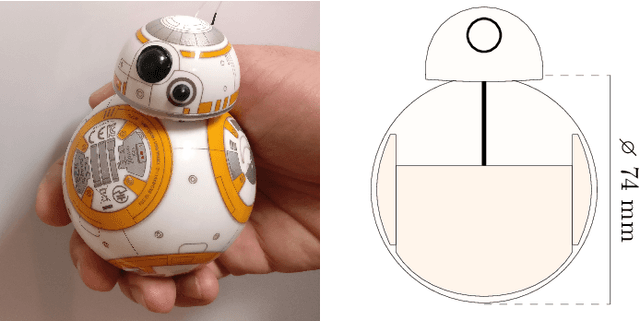

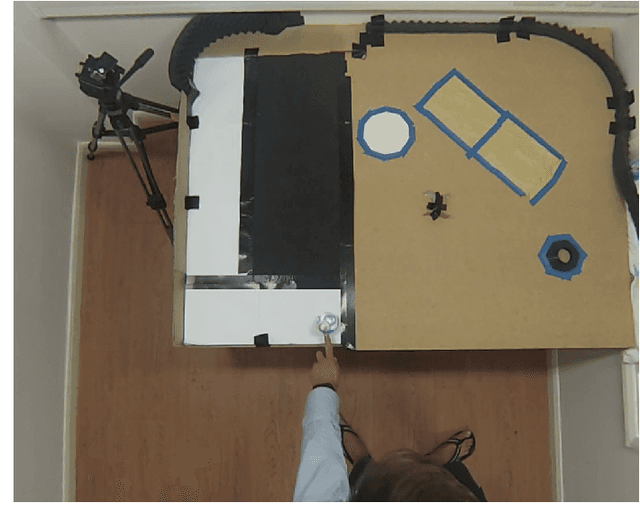
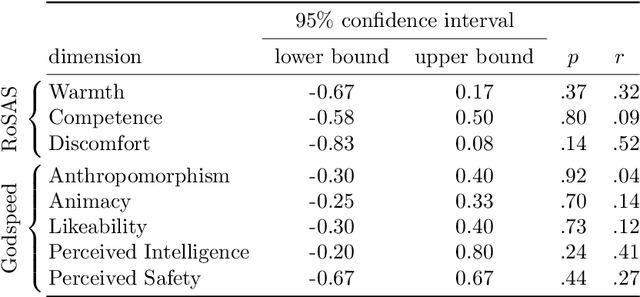
Abstract:A challenge in using fully autonomous robots in human-robot interaction (HRI) is to design behavior that is engaging enough to encourage voluntary, long-term interaction, yet robust to the perturbations induced by human interaction. Here we evaluate if an intrinsically motivated, physical robot can address this challenge. We use predictive information maximization as an intrinsic motivation, as simulated experiments showed that this leads to playful, exploratory behavior that is robust to changes in the robot's morphology and environment. To the authors' knowledge there are no previous HRI studies that evaluate the effect of intrinsically motivated behavior in robots on the human perception of those robots. We present a game-like study design, which allows us to focus on the interplay between the robot and the human participant. In contrast to a study design where participants order or control a robot to do a specific task, the robot and the human participants in our study design explore their behaviors without knowledge about any specific goals. We conducted a within-subjects study (N=24) were participants interacted with a fully autonomous Sphero BB8 robot with different behavioral regimes: one realizing an adaptive, intrinsically motivated behavior and the other being reactive, but not adaptive. A quantitative analysis of post-interaction questionnaires showed a significantly higher perception (r=.555, p=.007) of the dimension "Warmth" compared to the baseline behavior. Warmth is considered a primary dimension for social attitude formation in human cognition. A human perceived as warm (i.e. friendly and trustworthy) experiences more positive social interactions. If future work demonstrates that this transfers to human-robot social cognition, then the generic methods presented here could be used to imbue robots with behavior leading to positive perception by humans.
Superstition in the Network: Deep Reinforcement Learning Plays Deceptive Games
Aug 12, 2019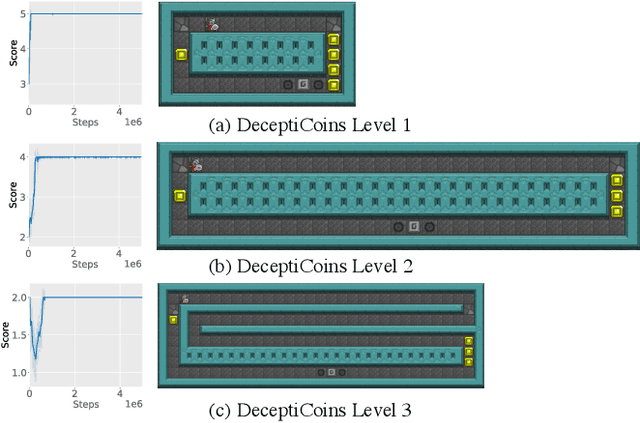
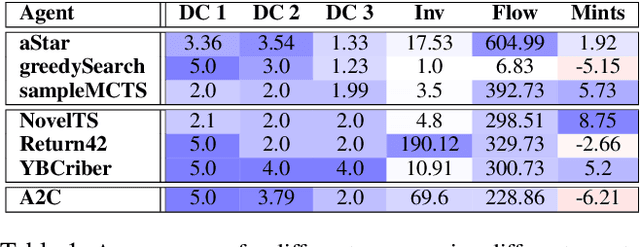
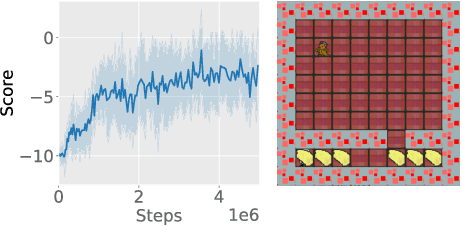
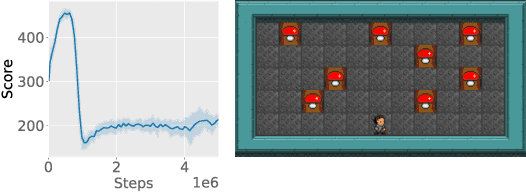
Abstract:Deep reinforcement learning has learned to play many games well, but failed on others. To better characterize the modes and reasons of failure of deep reinforcement learners, we test the widely used Asynchronous Actor-Critic (A2C) algorithm on four deceptive games, which are specially designed to provide challenges to game-playing agents. These games are implemented in the General Video Game AI framework, which allows us to compare the behavior of reinforcement learning-based agents with planning agents based on tree search. We find that several of these games reliably deceive deep reinforcement learners, and that the resulting behavior highlights the shortcomings of the learning algorithm. The particular ways in which agents fail differ from how planning-based agents fail, further illuminating the character of these algorithms. We propose an initial typology of deceptions which could help us better understand pitfalls and failure modes of (deep) reinforcement learning.
The Riddle of Togelby
Jun 10, 2019



Abstract:At the 2017 Artificial and Computational Intelligence in Games meeting at Dagstuhl, Julian Togelius asked how to make spaces where every way of filling in the details yielded a good game. This study examines the possibility of enriching search spaces so that they contain very high rates of interesting objects, specifically game elements. While we do not answer the full challenge of finding good games throughout the space, this study highlights a number of potential avenues. These include naturally rich spaces, a simple technique for modifying a representation to search only rich parts of a larger search space, and representations that are highly expressive and so exhibit highly restricted and consequently enriched search spaces.
 Add to Chrome
Add to Chrome Add to Firefox
Add to Firefox Add to Edge
Add to Edge